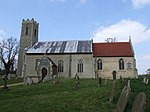Seething Airfield

Seething Airfield (ICAO: EGSJ), formerly RAF Seething, is located 9 NM (17 km; 10 mi) south southeast of Norwich, East Anglia, England. Seething Airfield (EGSJ) is a privately owned airfield in Norfolk, England and is home to the Waveney Flying Group. Situated in the village of Mundham, paradoxically just outside of Seething, south east of Norwich and just a few miles from the East Coast. The aerodrome is officially open to visitors Saturdays and Sundays from 0900 to around 1700 hrs (sunset in winter). Founded in 1960, the Waveney Flying Group leased the former USAAF airbase from local farmers and went on to purchase the land in 1963. Its close proximity to Great Yarmouth meant it saw quite a bit of celebrity use in the 60s and 70s when stars such as The Hollies, The Rolling Stones and Mike and Bernie Winters dropped in. In latter years, the new millennium has seen both the club house and hangars developed culminating with their official opening by Wing Cdr. Ken Wallis MBE in 2001.
Excerpt from the Wikipedia article Seething Airfield (License: CC BY-SA 3.0, Authors, Images).Seething Airfield
Hoseason Way, South Norfolk
Geographical coordinates (GPS) Address External links Nearby Places Show on map
Geographical coordinates (GPS)
| Latitude | Longitude |
|---|---|
| N 52.511111111111 ° | E 1.4172222222222 ° |
Address
Seething Airfield
Hoseason Way
NR14 6EW South Norfolk
England, United Kingdom
Open on Google Maps










